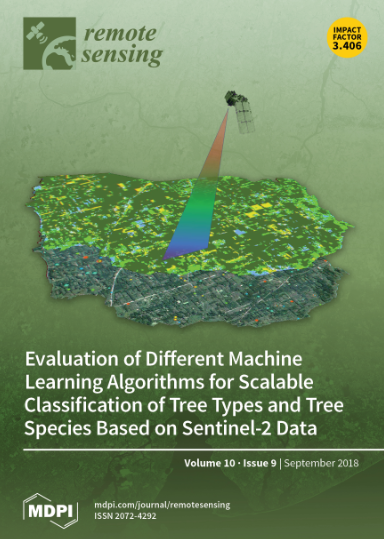Research on Multiscale Atmospheric Chaos Based on Infrared Remote-Sensing and Reanalysis Data
IF 4.2
2区 地球科学
Q2 ENVIRONMENTAL SCIENCES
引用次数: 0
Abstract
The atmosphere is a complex nonlinear system, with the information of its temperature, water vapor, pressure, and cloud being crucial aspects of remote-sensing data analysis. There exist intricate interactions among these internal components, such as convection, radiation, and humidity exchange. Atmospheric phenomena span multiple spatial and temporal scales, from small-scale thunderstorms to large-scale events like El Niño. The dynamic interactions across different scales, along with external disturbances to the atmospheric system, such as variations in solar radiation and Earth surface conditions, contribute to the chaotic nature of the atmosphere, making long-term predictions challenging. Grasping the intrinsic chaotic dynamics is essential for advancing atmospheric analysis, which holds profound implications for enhancing meteorological forecasts, mitigating disaster risks, and safeguarding ecological systems. To validate the chaotic nature of the atmosphere, this paper reviewed the definitions and main features of chaotic systems, elucidated the method of phase space reconstruction centered on Takens’ theorem, and categorized the qualitative and quantitative methods for determining the chaotic nature of time series data. Among quantitative methods, the Wolf method is used to calculate the Largest Lyapunov Exponents, while the G–P method is used to calculate the correlation dimensions. A new method named Improved Saturated Correlation Dimension method was proposed to address the subjectivity and noise sensitivity inherent in the traditional G–P method. Subsequently, the Largest Lyapunov Exponents and saturated correlation dimensions were utilized to conduct a quantitative analysis of FY-4A and Himawari-8 remote-sensing infrared observation data, and ERA5 reanalysis data. For both short-term remote-sensing data and long-term reanalysis data, the results showed that more than 99.91% of the regional points have corresponding sequences with positive Largest Lyapunov exponents and all the regional points have correlation dimensions that tended to saturate at values greater than 1 with increasing embedding dimensions, thereby proving that the atmospheric system exhibits chaotic properties on both short and long temporal scales, with extreme sensitivity to initial conditions. This conclusion provided a theoretical foundation for the short-term prediction of atmospheric infrared radiation field variables and the detection of weak, time-sensitive signals in complex atmospheric environments.基于红外遥感和再分析数据的多尺度大气混沌研究
大气层是一个复杂的非线性系统,其温度、水汽、压力和云层等信息是遥感数据分析的重要方面。这些内部成分之间存在着错综复杂的相互作用,如对流、辐射和湿度交换。大气现象跨越多个时空尺度,小到雷暴,大到厄尔尼诺等大尺度事件。不同尺度之间的动态相互作用,以及大气系统受到的外部干扰(如太阳辐射和地球表面状况的变化),造成了大气的混沌性质,使长期预测变得十分困难。把握内在的混沌动力学对推进大气分析至关重要,对加强气象预报、降低灾害风险和保护生态系统具有深远影响。为了验证大气的混沌性质,本文回顾了混沌系统的定义和主要特征,阐明了以塔肯斯定理为核心的相空间重构方法,并对确定时间序列数据混沌性质的定性和定量方法进行了分类。在定量方法中,沃尔夫法用于计算最大李雅普诺夫指数,G-P 法用于计算相关维数。为了解决传统 G-P 方法固有的主观性和噪声敏感性问题,一种名为 "改进饱和相关维度法 "的新方法被提出。随后,利用最大李亚普诺夫指数和饱和相关维数对 FY-4A 和 Himawari-8 遥感红外观测数据以及 ERA5 再分析数据进行了定量分析。结果表明,对于短期遥感数据和长期再分析数据,99.91%以上的区域点都有相应的最大李雅普诺夫指数为正的序列,所有区域点的相关维度都随着嵌入维度的增加而趋于饱和,其值大于1,从而证明大气系统在短时和长时尺度上都表现出混沌特性,对初始条件极为敏感。这一结论为短期预测大气红外辐射场变量和探测复杂大气环境中微弱的时间敏感信号提供了理论基础。
本文章由计算机程序翻译,如有差异,请以英文原文为准。
求助全文
约1分钟内获得全文
求助全文
来源期刊

Remote Sensing
REMOTE SENSING-
CiteScore
8.30
自引率
24.00%
发文量
5435
审稿时长
20.66 days
期刊介绍:
Remote Sensing (ISSN 2072-4292) publishes regular research papers, reviews, letters and communications covering all aspects of the remote sensing process, from instrument design and signal processing to the retrieval of geophysical parameters and their application in geosciences. Our aim is to encourage scientists to publish experimental, theoretical and computational results in as much detail as possible so that results can be easily reproduced. There is no restriction on the length of the papers. The full experimental details must be provided so that the results can be reproduced.
 求助内容:
求助内容: 应助结果提醒方式:
应助结果提醒方式:


